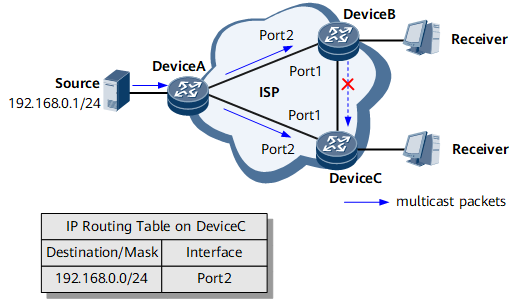RPF Check
Reverse path forwarding (RPF) check is a mechanism that determines whether a multicast packet is valid. RPF check works as follows: After receiving a multicast packet, a router looks up the packet source address in the unicast routing table, Multicast Border Gateway Protocol (MBGP) routing table, Multicast Interior Gateway Protocol (MIGP) routing table, and multicast static routing table to select an optimal route as an RPF route for the packet. If the interface on which the packet has arrived is an RPF interface, the RPF check succeeds, and the packet is forwarded. Otherwise, the RPF check fails, and the packet is dropped.
- By default, the system selects the RPF route based on the route
priority.
- The system compares the priorities of Rt_urt (migp), Rt_mbgp, and Rt_msr. The route with the smallest priority value is preferentially selected as the RPF route.
- If Rt_urt (migp), Rt_mbgp, and Rt_msr have the same priority, the system selects the RPF route in descending order of Rt_msr, Rt_mbgp, and Rt_urt (migp).
- If the multicast longest-match command is run
to control route selection based on the route mask:
- The system compares the mask lengths of Rt_urt (migp), Rt_mbgp, and Rt_msr. The route with the longest mask is preferentially selected as the RPF route.
- If Rt_urt (migp), Rt_mbgp, and Rt_msr have the same mask length, the system compares their priorities. The route with the smallest priority value is preferentially selected as the RPF route.
- If Rt_urt (migp), Rt_mbgp, and Rt_msr have the same mask length and priority, the system selects the RPF route in descending order of Rt_msr, Rt_mbgp, and Rt_urt (migp).
For example, on the network shown in Figure 1, Device C receives packets on both Port 1 and Port 2 from the same source. The routing table on Device C shows that the RPF interface for this source is Port 2. Therefore, the RPF check fails for the packet on Port 1 but succeeds for the packet on Port 2. Then, Device C drops the packet on Port 1 but forwards that packet on Port 2.
